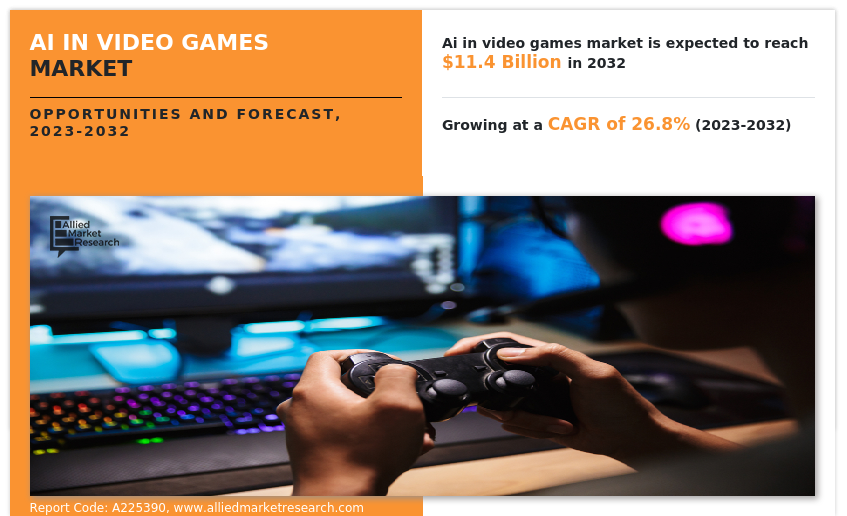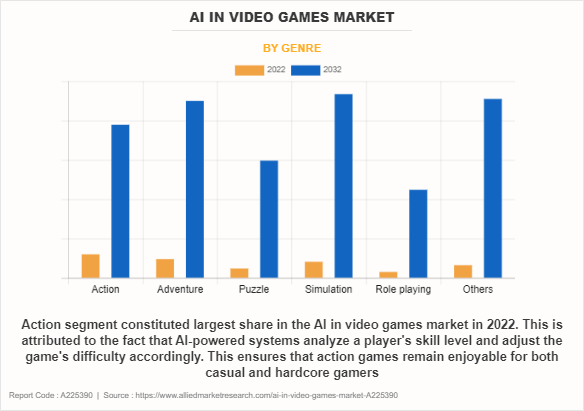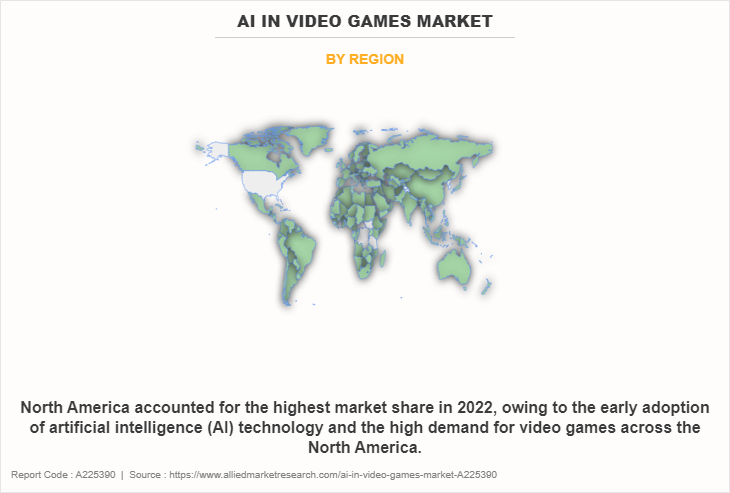AI In Video Games Market Statistics, 2032
The global ai in video games market was valued at $1.1 billion in 2022, and is projected to reach $11.4 billion by 2032, growing at a CAGR of 26.8% from 2023 to 2032.
AI in video gaming refers to responsive and adaptive video game experiences. These AI-powered interactive experiences are usually generated via non-player characters, or NPCs, that act intelligently or creatively, as if controlled by a human game-player. AI in gaming works to improve players’ gaming experience by making the virtual world more dynamic, complex and immersive. It plays a key role in various aspects of game development including human behavior, enemy design, world interaction, and system content generation.

The key factors that drive the growth of the AI in video games market include emergence of high bandwidth network connectivity and upsurge in the penetration of smartphones. The proliferation of smartphones has vastly expanded the user base for mobile games. This increased audience presents a lucrative market for game developers to implement AI-driven features, as they can reach a more diverse and substantial player demographic. Smartphones are powerful tools for collecting user data, including gameplay preferences, habits, and behaviors. Furthermore, the continuous improvement in processing capabilities, especially graphics processing units (GPUs) and central processing units (CPUs), is considered as an important driver for the growth of AI in the video game market.
However, increase in complexity and lack of expertise will hinder the growth of the market. AI in gaming requires complex algorithms and models. These algorithms must consider a wide range of variables including player behavior, environmental interaction, and non-player character (NPC) behavior. Complexity increases with sophisticated AI behaviors such as decision-making, strategy, and adaptability. Contrarily, the continuous demand for 3D games is expected to contribute to the growth of the AI in video games market during the forecast period. 3D games aim to provide lifelike graphics and environments. AI-powered graphics rendering techniques, such as ray tracing and image upscaling, can enhance the visual fidelity of 3D games. This results in more immersive and visually appealing gaming experiences.
The report focuses on growth prospects, restraints, and trends of the AI in video games market analysis. The study provides Porter’s five forces analysis to understand the impact of various factors, such as bargaining power of suppliers, competitive intensity of competitors, threat of new entrants, threat of substitutes, and bargaining power of buyers, on the AI in video games market.
Segment Review
The AI in video games market is segmented on the basis of component, technology, genre, and region. On the basis of component, the market is categorized into hardware, software, and service. On the basis of technology, the market is divided into machine learning, natural language processing, computer vision, gesture control, and others. On the basis of genre, it is divided into action, adventure, puzzle, simulation, role playing, and others. Region-wise, the market is analyzed across North America, Europe, Asia-Pacific, and LAMEA.

On the basis of genre, the action segment attained the highest AI in video games market size in 2022. This is because AI-powered systems analyse a player's skill level and adjust the game's difficulty accordingly. This ensures that action games remain enjoyable for both casual and hardcore gamers.

On the basis of region, North America held the highest AI in video games market share in 2022, owing to the early adoption of artificial intelligence technology and the high demand for video games across this region.
The report analyzes the profiles of key players operating in the AI in video games market such as Ubisoft, Google DeepMind, Inworld AI, NVIDIA Corporation, Unity Technologies, Latitude.io, Electronic Arts Inc., PrometheanAI Inc., Rockstar Games, and SideFX. These players have adopted various strategies to increase their market penetration and strengthen their position in the AI in video games industry.
Market Landscape and Trends
The AI in video games market has witnessed significant growth and evolution in recent years, driven by advancements in artificial intelligence technology and the increasing demand for more immersive and engaging gaming experiences. Moreover, machine learning and deep learning techniques are becoming increasingly prevalent in video game development. These technologies enable AI systems to learn and adapt from player behaviour, resulting in more dynamic and challenging gameplay.
In addition, game developers are investing in AI systems that can simulate human-like behaviour and emotions in NPCs. This includes facial expressions, body language, and decision-making based on emotional states. Furthermore, AI algorithms are being employed to generate dynamic and adaptive music and soundscapes in games. The music and sound effects change in response to in-game events, creating a more immersive audio experience.
Top Impacting Factors
Increased Processing Power
The continuous improvement in processing power, particularly in graphics processing units (GPUs) and central processing units (CPUs), allows AI algorithms to run in real-time. This means that AI-driven features, such as dynamic character behavior or advanced physics simulations, can be executed seamlessly within the gaming environment. Gamers can experience these AI-driven enhancements without noticeable lag or delays, leading to more engaging gameplay. Moreover, increased processing power empowers game developers to implement more complex AI behavior for non-player characters (NPCs) and opponents. These characters can exhibit sophisticated decision-making, adapt to player strategies, and provide a more challenging and realistic gaming experience.
For example, in open-world games, NPCs can react to the player's actions, leading to dynamic and unpredictable interactions. Furthermore, processing power is essential for implementing voice and speech recognition systems in games. AI-driven voice assistants, character interactions through natural language, and voice commands for in-game actions rely on robust processing capabilities for accurate and responsive interactions. All these trends drive the growth of the artificial intelligence in video games market.
Emergence of High Bandwidth Network Connectivity
High-bandwidth networks enable seamless real-time multiplayer gaming experiences. AI plays a crucial role in matchmaking, ensuring that players with similar skill levels are connected. Additionally, AI-driven anti-cheat systems can monitor player behavior in real-time, enhancing the integrity of online gaming environments. Moreover, high-bandwidth networks facilitate the efficient delivery of large game updates and downloadable content (DLC). AI-driven content recommendation systems can analyze player preferences and offer personalized content suggestions, leading to increased engagement and monetization opportunities.
Furthermore, high-bandwidth networks enable offloading AI processing to cloud-based servers. This can enhance the intelligence of non-player characters (NPCs) and opponents by allowing them to access more extensive AI models and databases. The AI-controlled entities can respond more realistically to player actions. Therefore, high-bandwidth connectivity has transformed the video game industry by creating an ecosystem in which AI can thrive.
Upsurge in the Penetration of Smartphones
The proliferation of smartphones has vastly expanded the user base for mobile games. This increased audience presents a lucrative market for game developers to implement AI-driven features, as they can reach a more diverse and substantial player demographic. Smartphones are powerful tools for collecting user data, including gameplay preferences, habits, and behaviors. AI algorithms can analyze this data to offer personalized gaming experiences, such as tailored challenges, character interactions, and content recommendations, thereby enhancing player engagement.
In addition, AI-driven upscaling and optimization techniques, such as DLSS (Deep Learning Super Sampling), can enhance graphics and performance in mobile games. Smartphones with high processing power can leverage these AI technologies to deliver visually stunning and responsive gaming experiences. Further, mobile games are incorporating AI-driven non-player characters (NPCs) and opponents with advanced behaviors and decision-making capabilities. This creates more dynamic and challenging gaming experiences on smartphones. Therefore, these factors are driving the growth of the artificial intelligence in video games market.
Increase in Complexity and Lack of Expertise
AI in video games requires complex algorithms and models. These algorithms must take into account a wide range of variables including player behavior, environmental interaction, and non-player character (NPC) behavior. Complexity increases with sophisticated AI behaviors such as decision-making, strategy, and adaptability. Moreover, many video games demand real-time AI processing, especially in fast-paced action games or online multiplayer environments. Achieving low-latency AI interactions while maintaining high-quality gameplay can be a complex technical challenge.
In addition, game developers need expertise in AI algorithms, machine learning, and deep learning techniques. This includes knowledge of neural networks, reinforcement learning, natural language processing, and computer vision, depending on the game's requirements. Furthermore, the gaming industry is continually evolving, and developers need the expertise to adapt AI technology to new trends and innovations. Staying updated with the latest AI advancements is crucial for staying competitive.
The Emergence of the 5G Network
5G networks offer significantly higher data speeds compared to previous generations. This means gamers can quickly download large game files and updates, reducing waiting times and enhancing the overall gaming experience. Additionally, streaming games from the cloud becomes more accessible and seamless with 5G, as games can be delivered with minimal latency. In addition, the combination of 5G and cloud gaming services allows players to access high-quality, console-level gaming experiences on a wide range of devices, including smartphones and tablets. This shift towards cloud gaming platforms opens up new opportunities for AI-enhanced gaming. The rendering of complex graphics and AI processing can be offloaded to remote servers, enabling even more advanced AI features.
Furthermore, 5G networks can facilitate edge computing, bringing AI processing closer to the player's device. This enables faster AI responses, reducing the need for data to travel to remote servers. Edge AI can enhance in-game AI behaviors, voice recognition, and other AI-driven features. Thus, these trends are anticipated to provide lucrative opportunities for AI in video games market growth.
Continuous Demand for 3D Games
3D games aim to provide lifelike graphics and environments. AI-powered graphics rendering techniques, such as ray tracing and image upscaling, can enhance the visual fidelity of 3D games. This results in more immersive and visually appealing gaming experiences. Realistic physics simulations are crucial for 3D games, where objects and characters interact with their surroundings. AI-driven physics engines can deliver more accurate and dynamic simulations, leading to more engaging and believable gameplay.
Further, AI-driven animation techniques, including procedural animation and machine learning-based character animation, enable characters in 3D games to move and behave more realistically. This enhances the overall immersion and player connection with the game world. In addition, AI can optimize dynamic lighting and visual effects in 3D games. Real-time ray tracing and AI-based image enhancement technologies create visually stunning and realistic lighting, shadows, and visual effects, elevating the gaming experience. Therefore, the continuous demand for 3D games is a driving force behind the integration of AI in video games Industry.
Key Benefits for Stakeholders
- This report provides a quantitative analysis of the market segments, current trends, estimations, and dynamics of the AI in video games market forecast from 2022 to 2032 to identify the prevailing market opportunities.
- Market research is offered along with information related to key drivers, restraints, and opportunities of AI in video games market outlook.
- Porter's five forces analysis highlights the potency of buyers and suppliers to enable stakeholders to make profit-oriented business decisions and strengthen their supplier-buyer network.
- In-depth analysis of the AI in video games market segmentation assists in determining the prevailing AI in video games market opportunity.
- Major countries in each region are mapped according to their revenue contribution to the global market.
- Market player positioning facilitates benchmarking and provides a clear understanding of the present position of the market players.
- The report includes an analysis of the regional as well as global AI in video games market trends, key players, market segments, application areas, and market growth strategies.
AI in Video Games Market Report Highlights
| Aspects | Details |
| Market Size By 2032 | USD 11.4 billion |
| Growth Rate | CAGR of 26.8% |
| Forecast period | 2022 - 2032 |
| Report Pages | 409 |
| By Component |
|
| By Technology |
|
| By Genre |
|
| By Region |
|
| Key Market Players | PrometheanAI Inc., NVIDIA Corporation, SideFX, Electronic Arts Inc., Rockstar Games, Inworld AI Solutions Inc., Unity Technologies, Latitude.io, Google DeepMind, Ubisoft |
Analyst Review
The growth of the global artificial intelligence in video games market can be attributed to various factors such as increasing demand for AI-enabled devices, rising adoption of cloud-based services, and growing demand for smart gaming consoles. In addition, the market players are also focusing on developing advanced gaming products and services to attract a larger customer base, which is positively influencing the overall industry. Furthermore, the population growth, broadening demographics, increased accessibility, social interaction, and connectivity, and changing perceptions and cultural acceptance of gaming led to a significant rise in number of gamers. These factors have contributed to the mainstream popularity of video games as a form of entertainment, leading to a growing number of players globally.
The market players are adopting strategies such as product launch for enhancing their services in the market and improving customer satisfaction. For instance, in February 2022, Latitude, developer of the popular AI Dungeon, an infinite text adventure powered by AI, launched Voyage, an online platform that helped users to discover, and create a variety of new experiences generated by artificial intelligence. With the release of Voyage, the company's development has entered a new stage, and its product lineup has grown beyond its flagship AI Dungeon game. The Voyage platform lets users explore, enjoy, and eventually create experiences that are endless and dynamic, supported by artificial intelligence, starting with four new experiences: Pixel This, Things, Loom, and Mediaeval Problems.
Moreover, some of the key players profiled in the report are Ubisoft, Google DeepMind, Inworld AI, NVIDIA Corporation, Unity Technologies, Latitude.io, Electronic Arts Inc., PrometheanAI Inc., Rockstar Games, and SideFX. These players have adopted various strategies to increase their market penetration and strengthen their position in the industry.
The AI in video games market is estimated to grow at a CAGR of 26.8% from 2023 to 2032.
The AI in video games market is projected to reach $11.42 billion by 2032.
Increased processing power, emergence of high bandwidth network connectivity, and upsurge in the penetration of smartphones contribute towards the growth of the market.
The key players profiled in the report include AI in video games market analysis includes top companies operating in the market such as Ubisoft, Google DeepMind, Inworld AI, NVIDIA Corporation, Unity Technologies, Latitude.io, Electronic Arts Inc., PrometheanAI Inc., Rockstar Games, and SideFX.
The key growth strategies of AI in video games players include product portfolio expansion, mergers & acquisitions, agreements, business expansion, and collaborations.
Loading Table Of Content...
Loading Research Methodology...



